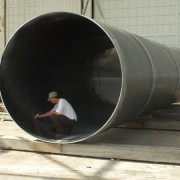What is FRP?
 Fiberglass reinforced plastic is not only versatile, but also offers a wide range of practical and environmental benefits. The ins and outs of FRP have given rise to a lot of questions over the years, so we’ve put together a short series of blog posts to cover some of the basics of FRP. Starting with…
Fiberglass reinforced plastic is not only versatile, but also offers a wide range of practical and environmental benefits. The ins and outs of FRP have given rise to a lot of questions over the years, so we’ve put together a short series of blog posts to cover some of the basics of FRP. Starting with…
What is FRP?
The term FRP, which is common throughout the industry, refers to plastic that has been reinforced with glass fibers. Fiberglass reinforced plastics (FRP) are used for many varied applications; from boats and bathtubs to missiles. However, examples of equipment currently fabricated out of fiberglass-reinforced plastics include FRP tanks and vessels, FRP pipe, FRP ductwork hoods, fans, scrubbers, stacks, grating, and specialty fabrications. One of the fastest growing areas is the use of FRP for pollution-control equipment.
What Can Be Used to Reinforce the Plastic?
Many reinforcements can be used for plastic materials-including polyester fibers, carbon fibers and, of course, glass fibers. For corrosion-resistant equipment, approximately 95% of the applications normally involve the use of glass fibers (with some polyester fibers being used on certain specific occasions.).
What Resins Are Typically Used?
Glass fibers can be added to virtually all of the thermosplastic and thermoset resins, For corrosion resistant equipment, the resins used are primarily those of the thermosetting type. These are resins that, once they have “hardened,” remain in their cured configuration when subjected to heat-up to their distortion temperature or the temperature at which they will degrade. Examples of thermoset resins include the epoxies, polyesters, vinyl-esters, and furan. There are other thermo- setting materials, but these four are used in the vast majority of applications for fiber-glass reinforced plastics. The term “polyester” is a generic one that refers to a wide range of materials. It can include everything from a general-purpose resin used in boats and bathtubs to the most exotic, high-temperature corrosion resins. For corrosion-resistant equipment, specialized corrosion-resistant-grade resins are available.
A number of companies manufacture isophthalic polyester resins, which have a distinct place in the hierarchy of corrosion-resistant materials. Very frequently, to reduce costs, a customer will have equipment built with one of the premium-grade resins used for the corrosion inner liner, the balance of the structural laminate being built with an isophthalic polyester resin.
One type of corrosion-resistant resin in use is the vinylester resin. The vinyl-esters are similar in corrosion resistance to the bisphenol A polyester resins, but for many applications, possess improved physical properties, especially impact and toughness.
The original vinyl-ester resin from Dow was known as Derakane 411. This is a very good resin up to 180°F, but the physical properties fall off very rapidly past that point.
Several years ago, Dow introduced Derakane 470 resin, with improved high-temperature properties and improved solvent resistance. Another addition from Dow has been Derakane 510, a fire-retardant vinyl-ester resin. This resin achieves its fire-retardancy without use of such materials as antimony trioxide.














